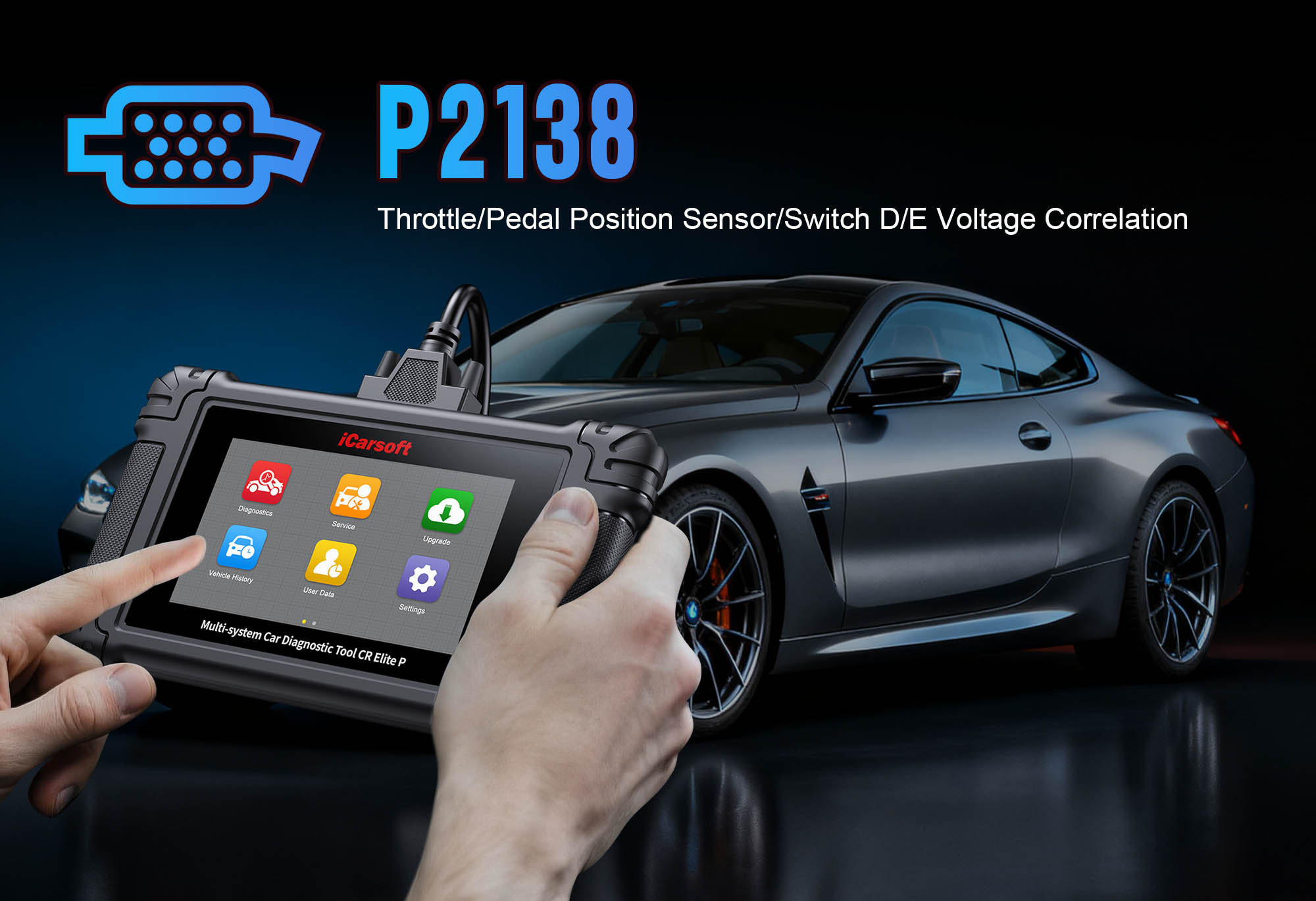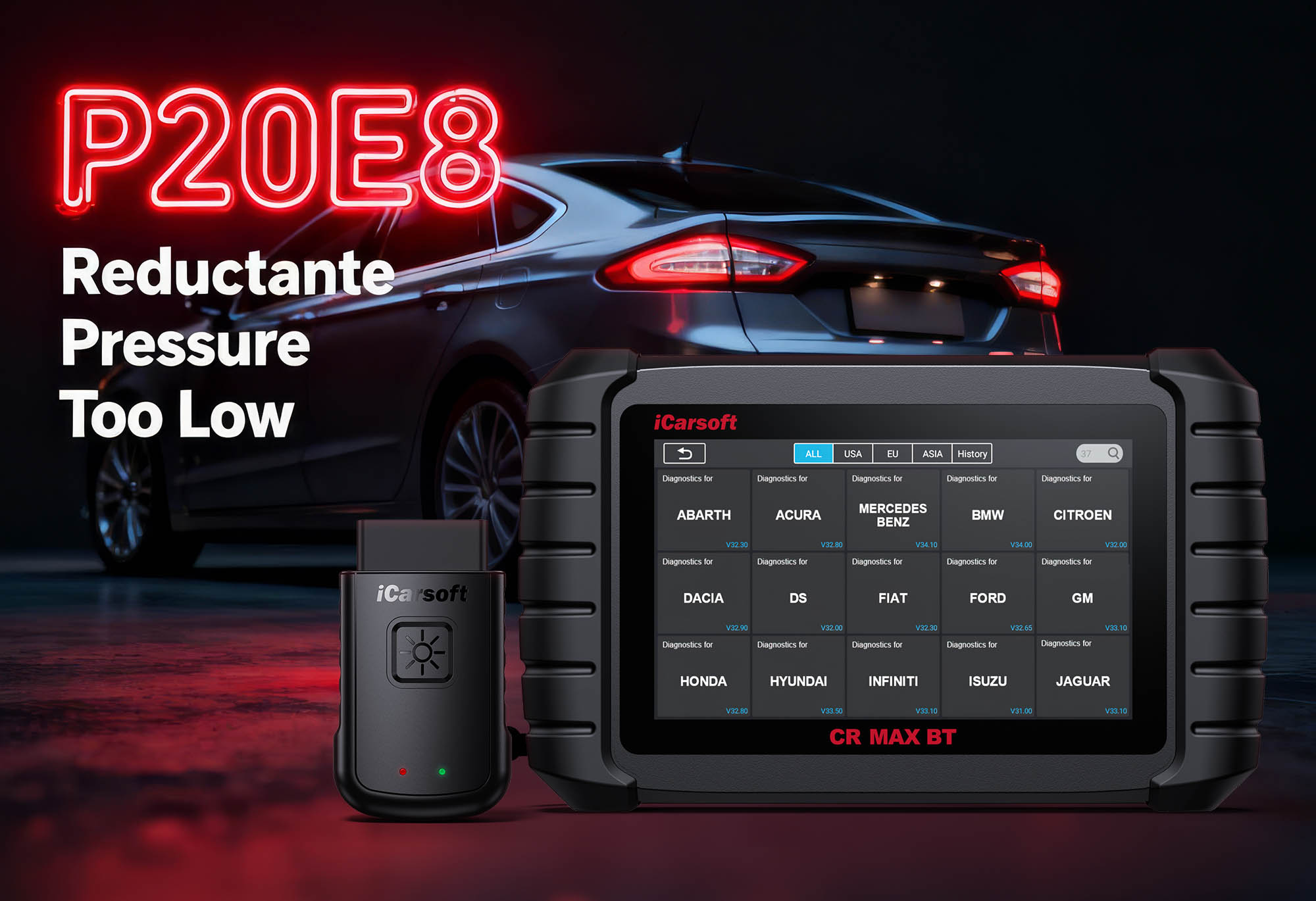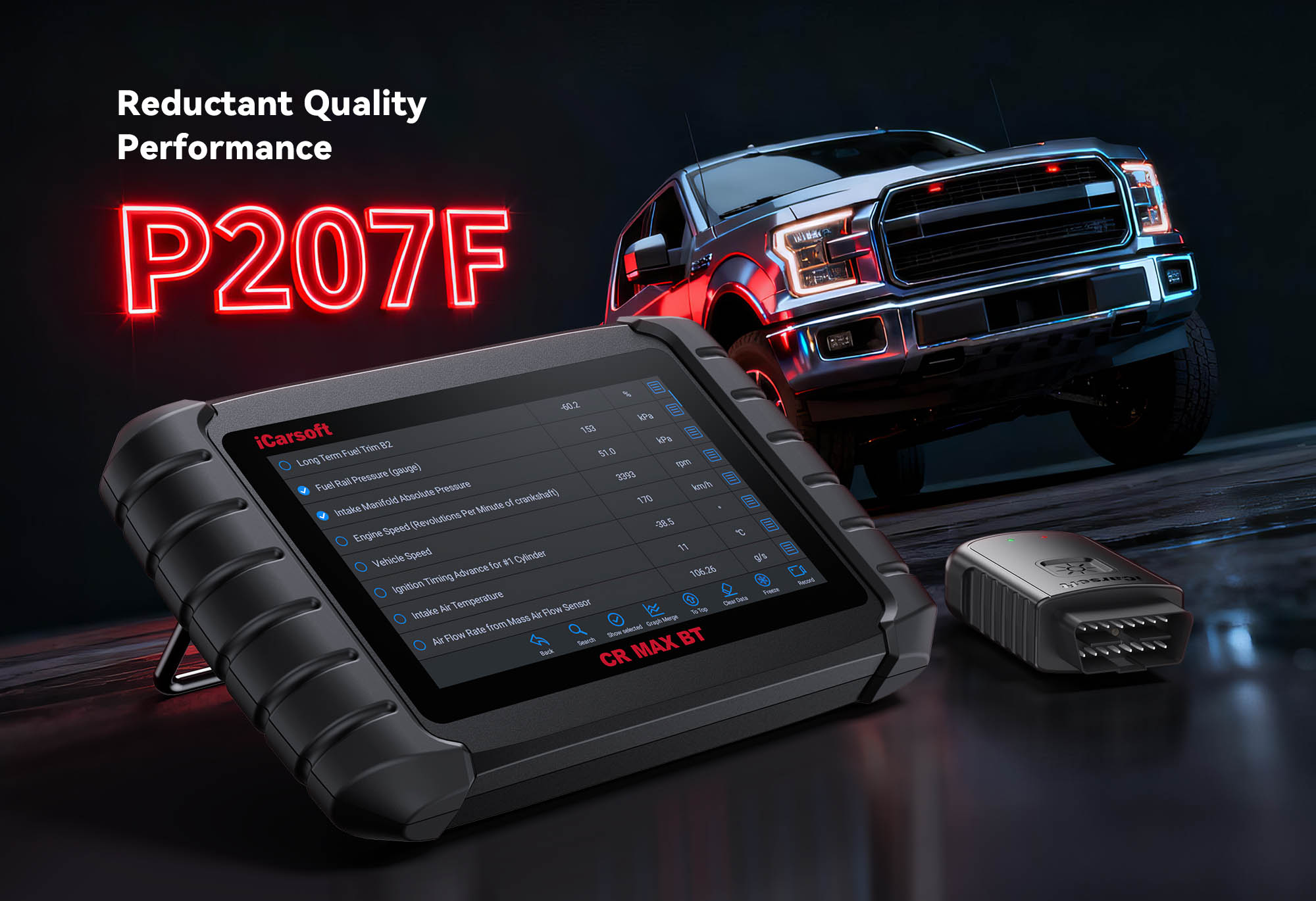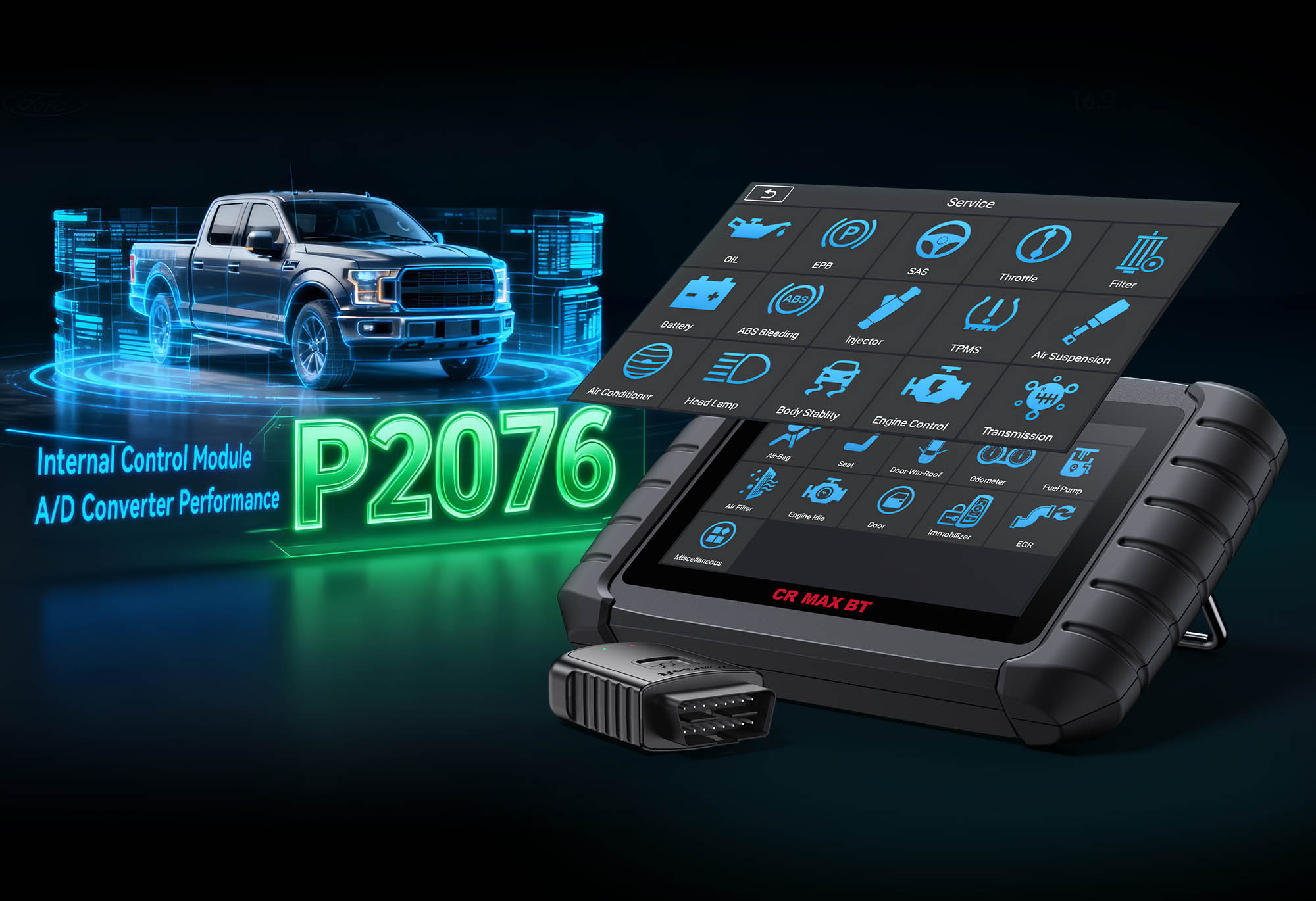Diagnose & Clear P2138 with iCarsoft CR Elite P: Fix Throttle/Pedal Position Sensor Voltage Mismatch
If your vehicle’s check engine light flashes, you feel sudden power loss, or the engine enters "Limp Mode" (limiting speed to 30–40 mph), a diagnostic scan will likely return P2138. This OBD-II code stands for "Throttle/Pedal Position Sensor/Switch A and B Voltage Correlation"—a critical fault indicating the Engine Control Module (ECM) has detected a mismatch between the voltage signals from two redundant sensors: the throttle position sensor (TPS, mounted on the throttle body) and the accelerator pedal position sensor (APP, mounted on the pedal). These sensors work together to regulate engine power—when their signals don’t align, the ECM limits power to prevent unsafe acceleration or engine damage.
Basic scanners may only flag "sensor voltage mismatch" but can’t track real-time sensor voltages, test throttle body movement, or check wiring integrity—leaving you unable to tell if the issue is a faulty sensor, broken wire, or dirty throttle body. The iCarsoft CR Elite P, with its specialized throttle system diagnostics, live voltage tracking, and bi-directional tests, solves this. Let’s break down how to diagnose and resolve P2138 with precision, leveraging the CR Elite P’s unique capabilities to restore safe, reliable engine performance.
Understanding P2138: Causes & Key Symptoms
A voltage mismatch between the TPS and APP sensors disrupts the ECM’s ability to adjust fuel and air delivery, leading to symptoms that demand immediate attention—ignoring P2138 can leave you stranded or cause accidental acceleration:
Key Symptoms of P2138
-
Check Engine Light (CEL) + Limp Mode: The CEL illuminates, and the ECM activates Limp Mode to limit power—this is a safety feature to prevent unregulated acceleration.
-
Sudden Power Loss: The engine may cut power unexpectedly during driving, especially when accelerating (e.g., merging onto highways).
-
Unresponsive Accelerator Pedal: Pressing the pedal has little to no effect—engine stays at idle or low RPM.
-
Rough Idle & Stalling: Mismatched sensor signals disrupt idle control, causing the engine to shake or stall when stopped.
-
Inconsistent Throttle Response: The engine may "surge" (suddenly increase RPM) even when the pedal is held steady.
-
Throttle Warning Light: Some vehicles (e.g., GM, Ford) display a dedicated "Throttle Fault" light on the dashboard.
Common Causes of P2138
|
Cause
|
Description
|
|
Faulty Accelerator Pedal Position (APP) Sensor
|
The APP sensor (with two internal circuits, A and B) sends voltage signals to the ECM—worn internal components cause signal mismatch.
|
|
Defective Throttle Position Sensor (TPS)
|
The TPS (mounted on the throttle body) monitors the throttle plate’s position—corrosion or electrical failure leads to erratic voltage.
|
|
Dirty/Stuck Throttle Body
|
Carbon buildup on the throttle plate prevents it from opening/closing smoothly, disrupting TPS signals.
|
|
Damaged Wiring Harness
|
Frayed wires, rodent chew marks, or corrosion in the TPS/APP sensor wiring create electrical resistance, causing voltage drops.
|
|
Loose or Corroded Connectors
|
The TPS or APP sensor’s electrical connector becomes loose or rusted, breaking the signal path to the ECM.
|
|
ECM Software Glitch
|
Outdated ECM firmware misinterprets sensor signals, triggering false P2138 codes—common in 2015+ vehicles with electronic throttle control (ETC).
|
Why iCarsoft CR Elite P Excels at Diagnosing P2138
The CR Elite P outperforms basic tools with features tailored to throttle and pedal position systems—critical for resolving P2138:
Live TPS/APP Voltage Tracking
Monitors real-time voltage from both TPS (A/B) and APP (A/B) sensors, showing if signals are within the ECM’s acceptable correlation range (typically, Sensor B voltage = 2x Sensor A voltage).
Throttle Body Adaptation/Reset
Resets the ECM’s throttle learned values (e.g., idle position) to fix minor signal mismatches caused by carbon buildup.
Bi-Directional Throttle Control
Sends commands to the electronic throttle body to open/close manually, verifying if the TPS responds correctly (rules out mechanical vs. electrical issues).
Wiring Circuit Integrity Tests
Checks for open circuits, short circuits, or high resistance in TPS/APP wiring, pinpointing electrical faults.
AutoVIN Identify
Automatically retrieves your vehicle’s make, model, and throttle system type in seconds, ensuring access to sensor-specific voltage specs.
Global Vehicle Coverage
Works with 500+ gasoline, diesel, and hybrid models from Ford, Chevrolet, Toyota, Honda, BMW—supports all electronic throttle control (ETC) systems.
Sensor Calibration Tests
Verifies if TPS/APP sensors are calibrated to manufacturer standards—out-of-calibration sensors often cause P2138.
Step-by-Step: Diagnose P2138 with iCarsoft CR Elite P
-
1. Initial Visual Inspection (Check for Obvious Issues)
Start with simple checks to rule out easy fixes before advanced diagnostics:
1. Throttle Body Inspection: Locate the throttle body (via Component Location > Engine > Throttle Body). Remove the air intake tube and check for carbon buildup on the throttle plate.
2. Sensor Connectors: Inspect TPS (throttle body) and APP (accelerator pedal) connectors for corrosion/bent pins—clean with electrical contact cleaner.
3. Wiring Harness: Examine wiring for frayed insulation, rodent damage, or kinks—repair small damages with heat-shrink tubing.
-
2. Connect the CR Elite P & Confirm P2138
1. Plug the CR Elite P into the OBD-II port. Power on and select AutoVIN Identify to detect throttle system type and ECM software.
2. Navigate to Engine > Fault Codes > Read Codes to confirm P2138. Tap Code Details for vehicle-specific insights (e.g., "Silverado: TPS A/B Mismatch; A:0.8V, B:1.0V (Expected:1.6V)").
3. Resolve related codes (e.g., P0121, P0221) first—they indicate individual sensor faults that cause P2138.
-
3. Monitor Live TPS/APP Voltage Data
Real-time voltage reveals which sensor causes the mismatch:
1. Start the engine, idle 5 minutes (warm to operating temp).
2. Navigate to Engine > Live Data > Throttle/Pedal Position and monitor:
- APP Sensor A/B: Idle (pedal off): A≈0.5V, B≈1.0V (B=2x A); 100% pedal: A≈4.5V, B≈2.25V (B=0.5x A).
- TPS Sensor A/B: Idle (throttle closed): A≈0.9V, B≈4.1V; WOT: A≈4.1V, B≈0.9V.
3. Correlation Check: If B voltage isn’t 1.8–2.2x A (idle) or 0.45–0.55x A (WOT), the sensor is faulty/miswired.
-
4. Perform Throttle Body Cleaning & Adaptation
Carbon buildup disrupts TPS signals—clean and reset adaptations:
1. Clean the Throttle Body: Turn off engine, disconnect battery negative. Remove throttle body (torque specs via Torque Guide: 8–10 Nm). Spray with throttle body cleaner, brush off carbon, dry with compressed air.
2. Reinstall & Adapt: Reattach throttle body and battery. Start engine, idle 2 minutes.
3. Reset Adaptations: Navigate to Special Functions > Engine > Throttle Body Adaptation—follow prompts to reset learned values. Check if P2138 reappears.
-
5. Test TPS/APP Sensors with Bi-Directional Control
Verify sensor response to manual commands:
1. Throttle Control Test: Vehicle in "Park," parking brake engaged. Navigate to Special Functions > Engine > Throttle Control Test.
2. Command throttle to 20%/50%/80%—monitor TPS voltage:
- Good TPS: Voltage changes smoothly with command (e.g., 20% = 1.5V).
- Faulty TPS: Erratic/no voltage change (replace throttle body—modern TPS are integrated).
3. APP Sensor Test: Engine off. Press pedal to 25%/50%/75%—monitor APP voltage:
- Good APP: Voltage increases linearly (e.g., 25% = 1.5V).
- Faulty APP: Jumps/flatlines (replace accelerator pedal assembly—APP is integrated).
-
6. Test TPS/APP Wiring & Circuits
Rule out electrical faults:
1. Engine off, disconnect TPS/APP connectors.
2. Power Wire Test: Multimeter (DC Voltage) on sensor power pin + ground. Ignition "ON": 5V (most) or 12V (Chrysler). 0V = blown fuse (check via Fuse Guide).
3. Signal Wire Test: Multimeter (Ohms) between sensor signal pin and ECM pin (via Wiring Diagram). Normal: <5 ohms; >10 ohms = damaged wire.
4. Ground Wire Test: Multimeter (Ohms) on sensor ground pin + chassis. Normal: <1 ohm; >5 ohms = clean/replace ground strap.
-
7. Update ECM Firmware (False Code Suspected)
Outdated software misinterprets signals—update firmware:
1. Connect CR Elite P to Wi-Fi (System > Wi-Fi Settings).
2. Navigate to System > Update Manager > ECM Firmware—scan for updates (e.g., "Camry 2019–2022: Throttle Sensor Calibration").
3. Install updates, restart engine. Clear P2138 and check if it returns.
-
8. Repair & Clear P2138
Fix the root cause:
- Dirty Throttle Body: Completed in step 4.
- Faulty APP Sensor: Replace accelerator pedal assembly (OEM part via Part Lookup).
- Faulty TPS: Replace throttle body (ensure OEM-equivalent).
- Wiring Faults: Repair with heat-shrink tubing; replace damaged harness.
- ECM Glitch: Install firmware updates (step 7).
Clear Code: Navigate to Engine > Fault Codes > Clear Codes. Reset Limp Mode (if active) via Special Functions > Engine > Limp Mode Reset.
-
9. Validate the Repair
Ensure sensors sync and P2138 doesn’t return:
1. Start engine—no CEL, Throttle Fault light, or Limp Mode.
2. Test drive 30–40 minutes (city + highway):
- Smooth throttle response; no power loss/surging.
- Responsive pedal (linear RPM increase).
- No stalling/rough idle at stops.
3. Post-Repair Data: Confirm TPS/APP voltages are in correlation range (B=1.8–2.2x A at idle) via live data.
4. Run I/M Readiness Test (under OBDII Functions) for emissions compliance.
Preventing P2138 Recurrence
The CR Elite P maintains throttle system health to avoid future issues:
-
Throttle Body Maintenance: Use Service Reminder to clean every 30,000 miles—prevents carbon buildup.
-
Sensor Checks: Schedule TPS/APP voltage tests every 60,000 miles—catch early mismatches before P2138.
-
Wiring Protection: Inspect wiring every 15,000 miles for rodent damage/corrosion—use wire loom to protect vulnerable sections.
-
ECM Updates: Enable auto-Wi-Fi updates to install throttle calibration fixes as manufacturers release them.
Conclusion
P2138’s throttle/pedal sensor voltage mismatch is a safety-critical fault, but the iCarsoft CR Elite P simplifies diagnosis with live voltage tracking, bi-directional tests, and wiring checks. Whether cleaning a throttle body, replacing a sensor, or updating ECM firmware, this tool ensures you address the root cause—avoiding dangerous driving conditions and costly dealer repairs.
For DIYers and professionals alike, the CR Elite P’s throttle system expertise, global coverage, and intuitive interface make it the ideal tool for resolving P2138. Restore responsive acceleration, disable Limp Mode, and drive with confidence—all with one professional-grade diagnostic tool.
FAQs About P2138 Code
Q: Can I drive with P2138?
A: No—P2138 causes unpredictable power loss or unresponsive pedals, which is a safety hazard. Tow the vehicle to a shop or fix it immediately; do not attempt long drives.
Q: How much does it cost to fix P2138?
A: Costs range from $20–$50 for throttle body cleaning, $100–$300 for an APP sensor/pedal assembly, $150–$400 for a throttle body (with integrated TPS), and $80–$200 for wiring repairs. The CR Elite P saves by avoiding unnecessary sensor swaps.
Q: Why does P2138 return after sensor replacement?
A: Unresolved issues—e.g., dirty throttle body, damaged wiring, or outdated ECM firmware. Use the CR Elite P to retest live voltages and circuit integrity after replacement.
Q: Do I need to calibrate new TPS/APP sensors after replacement?
A: Yes—most modern vehicles require calibration to sync the new sensor with the ECM. Use the CR Elite P’s Special Functions > Engine > Sensor Calibration to complete the process; skip this step and P2138 will reappear.





